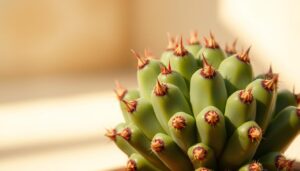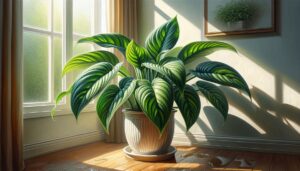Introduction
Delving into the realm of botanical propagation opens up a world of possibilities for nurturing and expanding your indoor jungle. Among the most coveted and striking specimens in the horticultural repertoire is the fiddle leaf fig (Ficus lyrata). Renowned for its large, violin-shaped leaves and air-purifying qualities, the fiddle leaf fig has become a staple in interior décor, gracing countless homes and offices with its majestic presence.
For those enchanted by the allure of the fiddle leaf fig, the journey from admiring this botanical marvel to nurturing one’s own verdant oasis begins with propagation. This artful process allows enthusiasts to cultivate new plants from established ones, unlocking the potential for exponential growth and the perpetuation of green beauty.
In this comprehensive guide, we will explore the intricacies of fiddle leaf fig propagation, equipping you with the knowledge and techniques needed to propagate with confidence. From understanding the anatomy of the fiddle leaf fig to mastering the various propagation methods, embark on this botanical voyage as we unravel the secrets to fostering flourishing foliage within your own sanctuary.
Understanding Fiddle Leaf Fig Anatomy:
Before delving into the art of propagation, it’s essential to familiarize yourself with the anatomy of the fiddle leaf fig. Understanding the structure of this beloved botanical specimen will provide insight into where and how propagation can be successfully initiated.
- Stem and Nodes: The stem of the fiddle leaf fig serves as the central axis from which leaves and branches emerge. Along the stem, you’ll find nodes, which are points of potential growth. Nodes play a crucial role in propagation, as they harbor dormant buds capable of sprouting new roots and shoots when triggered under the right conditions.
- Leaves: The hallmark feature of the fiddle leaf fig is its large, glossy leaves, reminiscent of a violin or fiddle, hence its name. Each leaf is composed of a sturdy petiole attached to the stem and a broad, veined blade that maximizes photosynthetic surface area. While leaves are not directly involved in propagation, they provide the energy necessary for new growth to emerge.
- Root System: Beneath the soil surface, the fiddle leaf fig develops a complex network of roots that anchor the plant and absorb water and nutrients from the surrounding substrate. When propagating, the goal is to encourage the development of new roots from existing plant material, enabling the establishment of a self-sustaining root system in the propagated specimen.
Methods of Fiddle Leaf Fig Propagation:
Now that we’ve acquainted ourselves with the key components of fiddle leaf fig anatomy, let’s explore the various methods of propagation available to enthusiasts:
- Stem Cutting Propagation:
- Select a healthy stem with at least two nodes.
- Using a clean, sharp blade, make a diagonal cut just below a node.
- Remove any lower leaves to expose the node.
- Dip the cut end in rooting hormone (optional) to encourage root development.
- Plant the cutting in a well-draining potting mix, ensuring the node is below the soil surface.
- Keep the soil consistently moist and provide indirect light to promote root growth.
- Air Layering Propagation:
- Identify a healthy section of stem and make a shallow incision just below a node.
- Enclose the incision with moist sphagnum moss and wrap it with plastic wrap to create a humid environment.
- After several weeks, roots will begin to form within the moss.
- Once roots are established, carefully remove the rooted section and plant it in a separate container with potting mix.
Propagation Conditions and Care:
Successful propagation of fiddle leaf figs requires more than just the right technique; it also hinges on creating optimal environmental conditions and providing attentive care throughout the propagation process. Let’s explore the key factors to consider when propagating these iconic houseplants:
- Light:
- Fiddle leaf figs thrive in bright, indirect light. When propagating, place newly rooted cuttings or air-layered sections in a location with ample but filtered sunlight.
- Avoid exposing propagated plants to direct sunlight, as this can scorch delicate new growth and impede root development.
- Supplemental grow lights can be used to provide consistent, gentle illumination if natural light is insufficient.
- Temperature and Humidity:
- Fiddle leaf figs prefer warm, humid environments reminiscent of their native tropical habitat. Maintain temperatures between 65°F to 75°F (18°C to 24°C) and humidity levels above 50%.
- To enhance humidity, place propagated plants in a humidifier-equipped room or regularly mist them with water. Alternatively, create a humidity tent by covering the plants with a clear plastic bag or dome.
- Watering:
- Proper watering is crucial during the propagation phase to prevent root rot and dehydration. Keep the soil consistently moist but not waterlogged.
- Monitor soil moisture levels regularly and adjust watering frequency as needed based on environmental conditions and plant response.
- Use room-temperature water to avoid shocking the sensitive root systems of propagated fiddle leaf figs.
- Potting Mix:
- Choose a well-draining potting mix tailored to the needs of fiddle leaf figs, such as a blend of peat moss, perlite, and pine bark.
- Avoid compacted or heavy soils that retain excess moisture, as these can suffocate delicate roots and hinder growth.
- Consider adding organic matter or compost to enrich the potting mix and provide essential nutrients for healthy development.
- Fertilization:
- Limit fertilization during the initial stages of propagation to prevent fertilizer burn and encourage root establishment.
- Once propagated plants demonstrate vigorous growth and establish a robust root system, begin incorporating a balanced, water-soluble fertilizer at half-strength into your regular watering routine.
- Monitor plant response to fertilizer and adjust dosage accordingly to avoid over-fertilization.
Troubleshooting Common Propagation Challenges:
While propagating fiddle leaf figs can be a rewarding endeavor, it may also present challenges along the way. Understanding and effectively addressing common issues that arise during propagation are essential for ensuring the success and vitality of your propagated plants. Let’s explore some potential challenges and troubleshooting strategies:
- Slow or No Root Development:
- If propagated cuttings or air-layered sections exhibit slow or no root development, reassess environmental conditions. Ensure adequate warmth, humidity, and moisture levels to promote root growth.
- Consider using a rooting hormone to stimulate root initiation and development, particularly for stem cuttings. Choose a hormone formulation specifically designed for woody plants.
- Yellowing or Wilting Leaves:
- Yellowing or wilting leaves on propagated fiddle leaf figs may indicate overwatering, underwatering, or environmental stress. Assess soil moisture levels and adjust watering frequency accordingly to maintain consistent moisture without waterlogging.
- Check for signs of root rot, such as foul odor or dark, mushy roots. If root rot is present, carefully trim affected roots and repot the propagated plant in fresh, well-draining soil.
- Pest Infestations:
- Pests such as spider mites, aphids, and mealybugs can pose a threat to propagated fiddle leaf figs. Inspect plants regularly for signs of pest infestation, including webbing, stippling on leaves, and sticky residue.
- Treat infested plants promptly using organic or chemical insecticides, following product instructions carefully to minimize harm to the plant and its environment.
- Isolate infested plants to prevent the spread of pests to other specimens in your collection.
- Drooping or Leggy Growth:
- Drooping or leggy growth in propagated fiddle leaf figs may indicate insufficient light or improper pruning. Ensure plants receive adequate indirect sunlight to promote compact, upright growth.
- Prune leggy stems or branches to encourage branching and bushier growth. Trim back elongated growth to a node or leaf to redirect energy toward new growth points.
- Transplant Shock:
- Transplant shock can occur when propagating fiddle leaf figs if root systems are disturbed or plants are exposed to sudden environmental changes. Minimize transplant shock by handling propagated plants gently and transplanting them into appropriately sized containers filled with fresh potting mix.
- Provide extra care and attention to newly transplanted specimens, including maintaining stable environmental conditions and avoiding stressors such as excessive heat or cold.
Expanding Your Fiddle Leaf Fig Collection:
Once you’ve successfully propagated your fiddle leaf fig and witnessed the joy of nurturing new growth, you may find yourself eager to expand your collection further. Fortunately, there are several avenues for acquiring additional specimens and diversifying your indoor jungle:
- Propagation from Established Plants:
- Continue propagating fiddle leaf figs from established specimens to generate a steady supply of new plants. Regularly assess your existing plants for suitable cuttings or air-layering opportunities, ensuring to propagate responsibly and avoid overharvesting.
- Plant Exchanges and Swaps:
- Participate in plant exchanges or swaps with fellow gardening enthusiasts to acquire new fiddle leaf fig varieties and cultivars. Local gardening clubs, online forums, and social media groups are excellent platforms for connecting with like-minded individuals interested in trading plants.
- Nurseries and Garden Centers:
- Visit nurseries and garden centers specializing in houseplants to explore a wide selection of fiddle leaf figs and other botanical treasures. Take the time to inspect plants for signs of health and vigor before making a purchase, and inquire about specific cultivars or rare varieties that pique your interest.
- Online Plant Retailers:
- Browse reputable online plant retailers that offer a diverse range of fiddle leaf figs and provide detailed descriptions of each plant’s characteristics. Take advantage of customer reviews and ratings to gauge the quality and reliability of different vendors, and consider purchasing from sources that prioritize sustainable and eco-friendly practices.
- Botanical Gardens and Arboretums:
- Explore botanical gardens and arboretums in your area or during travel excursions to admire fiddle leaf figs in their natural habitat and gain inspiration for your own collection. Some botanical institutions may also offer plant sales or propagation workshops where you can acquire rare or exotic specimens.
- DIY Tissue Culture:
- For the adventurous gardener interested in more advanced propagation techniques, consider experimenting with tissue culture to propagate fiddle leaf figs on a larger scale. Tissue culture involves growing plants from small tissue samples under sterile laboratory conditions, offering the potential to mass-produce genetically identical clones.
Creative Display and Styling Tips:
Elevating your fiddle leaf figs from mere houseplants to stunning design elements within your living space involves thoughtful consideration of display and styling techniques. With a touch of creativity and ingenuity, you can showcase your propagated specimens in ways that enhance the aesthetic appeal of your home while fostering a harmonious connection with nature. Here are some creative display and styling tips to inspire your botanical endeavors:
- Statement Planters:
- Selecting the right planter can elevate the visual impact of your fiddle leaf fig while complementing your interior décor. Consider oversized ceramic pots, woven baskets, or sleek metal containers to make a bold statement and add a touch of personality to your space.
- Experiment with different textures, colors, and shapes to create visual interest and harmonize with existing design elements. Incorporating planters with geometric patterns or intricate detailing can infuse your space with modern sophistication or bohemian charm.
- Layered Greenery:
- Embrace the beauty of layering by incorporating fiddle leaf figs into lush green vignettes alongside other houseplants. Create dynamic compositions by varying the heights, shapes, and textures of plants to establish visual depth and dimension.
- Combine fiddle leaf figs with trailing vines, cascading ferns, and compact succulents to craft captivating indoor gardens that invite exploration and admiration. Grouping plants of varying heights and forms can mimic the natural diversity found in forest ecosystems, fostering a sense of tranquility and abundance.
- Vertical Gardens:
- Maximize limited floor space by embracing vertical gardening techniques to display your fiddle leaf figs in innovative ways. Install wall-mounted planters, floating shelves, or vertical plant stands to create living green walls that serve as striking focal points within your home.
- Arrange fiddle leaf figs at different heights along vertical surfaces to create visual intrigue and draw the eye upward, effectively utilizing vertical space while adding a touch of botanical elegance to bare walls.
- Styling with Accessories:
- Enhance the visual appeal of your fiddle leaf fig display by incorporating decorative accessories that complement its aesthetic. Introduce elements such as decorative rocks, pebbles, or moss to add texture and contrast to the soil surface.
- Accentuate the natural beauty of your fiddle leaf figs with carefully curated plant accessories, such as decorative plant stakes, macramé hangers, or ceramic plant tags. These embellishments can serve as whimsical accents that reflect your personal style and infuse your space with character.
- Seasonal Décor:
- Celebrate the changing seasons by incorporating seasonal décor elements into your fiddle leaf fig displays. Adorn plants with festive ornaments, garlands, or string lights during the holiday season to create a festive ambiance and spread seasonal cheer.
- Explore seasonal color palettes and botanical motifs to inspire creative styling arrangements that evolve with the rhythm of nature. Incorporating seasonal blooms, foliage, or decorative accents can breathe new life into your fiddle leaf fig display and evoke a sense of seasonal harmony.
Conclusion: Cultivating Green Harmony
As we conclude our journey through the art and science of propagating fiddle leaf figs, we emerge with a newfound appreciation for the beauty, resilience, and transformative power of botanical propagation. From mastering propagation techniques to overcoming challenges and unleashing creative potential, the process of nurturing fiddle leaf figs embodies the symbiotic relationship between humans and nature—a partnership grounded in care, patience, and reverence for the living world.
Through propagation, we not only multiply our green companions but also cultivate a deeper connection to the natural rhythms and cycles that sustain life. Each propagated fiddle leaf fig serves as a testament to our capacity to nurture and steward the earth’s precious biodiversity, fostering ecosystems of abundance within the confines of our homes and hearts.
As we tend to our propagated specimens with tenderness and devotion, we become guardians of green harmony, weaving threads of vitality and vitality into the fabric of our daily lives. Whether displayed as solitary sentinels or integrated into lush botanical tapestries, fiddle leaf figs remind us of the transformative power of greenery to uplift, inspire, and rejuvenate the human spirit.
In the ever-unfolding story of botanical propagation, may we continue to cultivate green spaces that nourish the body, mind, and soul, forging deeper connections with the natural world and fostering a legacy of stewardship for generations to come. With each propagated fiddle leaf fig, we sow seeds of hope, growth, and renewal, infusing our lives with the timeless beauty of nature’s embrace.
Thanks for visiting us, if you are nearby stop and see us at The Landscape Connection.




